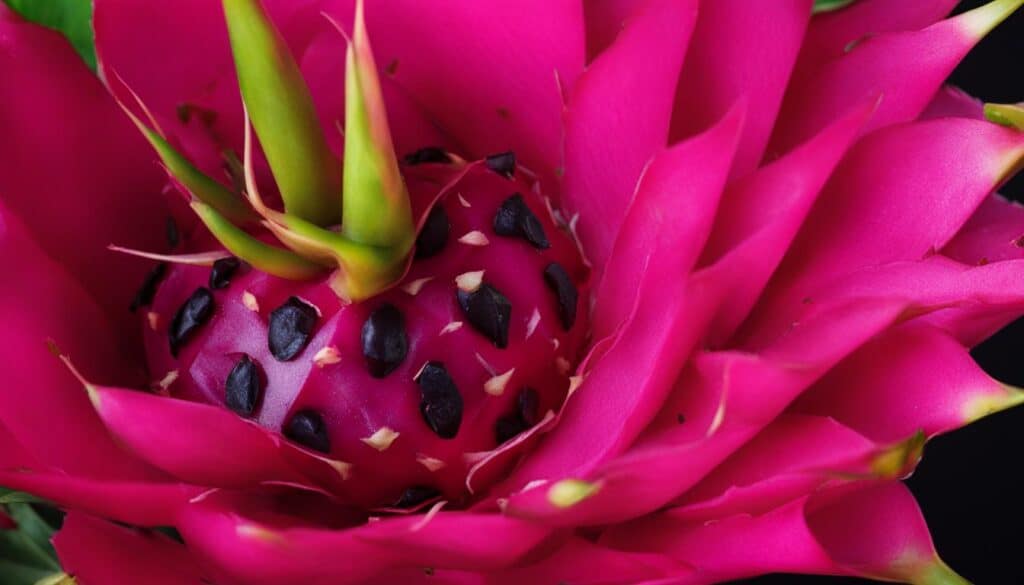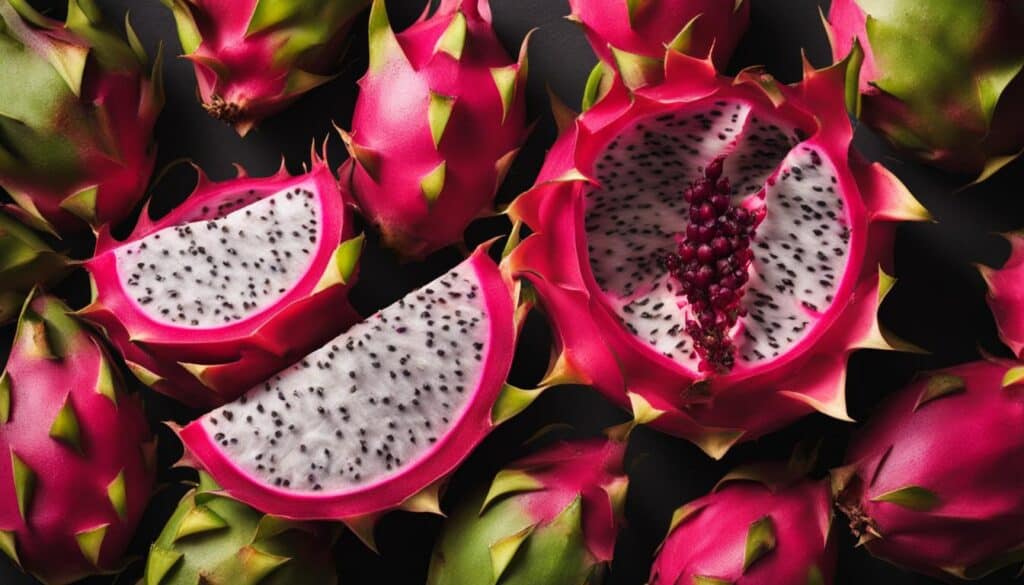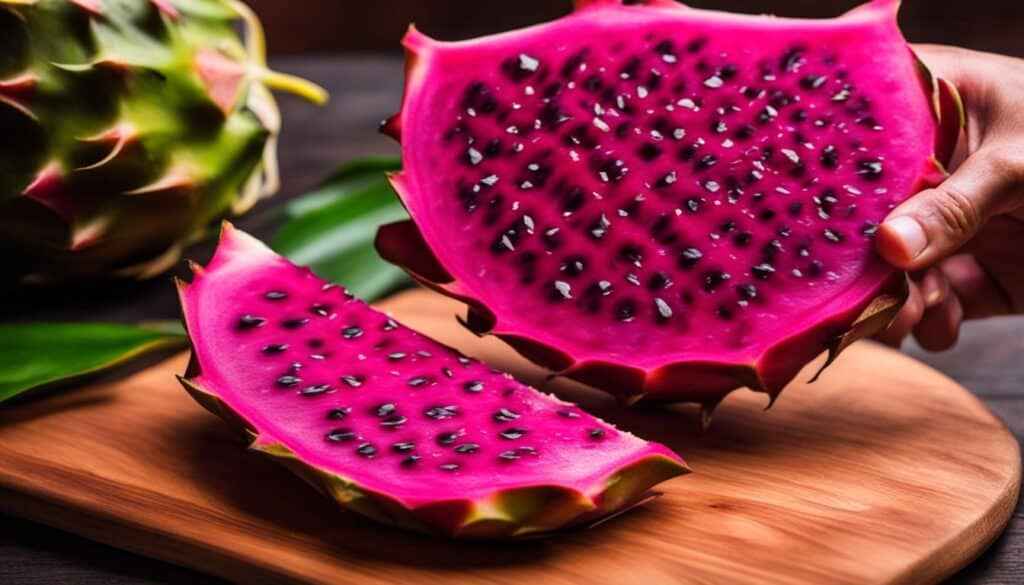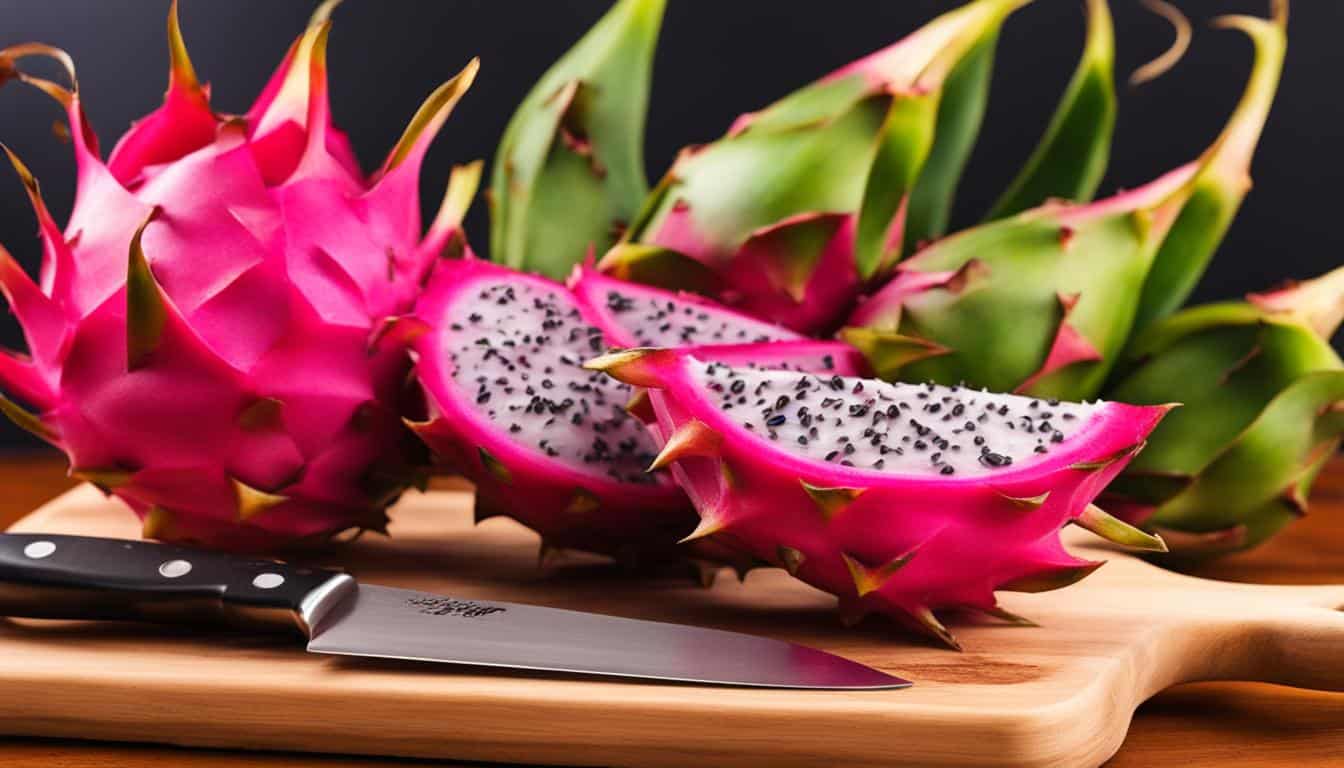Dragon fruit, also known as pitaya, is a vibrant and exotic fruit with a unique appearance and taste. It can be challenging to determine when a dragon fruit is ripe and ready to eat. To help you with this, I have compiled the ultimate guide to knowing when dragon fruit is ripe. This guide includes visual indicators, tactile sensations, and tasting techniques to ensure you choose the perfect dragon fruit for your next culinary adventure.
- Visual inspection is an effective way to determine if a dragon fruit is ripe.
- A ripe dragon fruit should have a soft and juicy texture and a delicate sweetness.
- Smell the fruit near the stem end to check for a sweet and fruity aroma.
- Harvest dragon fruit when the skin color has changed and the small leaves start to fade.
- Knowing when dragon fruit is ripe allows you to enjoy it at its peak flavor and texture.
Characteristics of Ripe Dragon Fruit
Ripe dragon fruit possesses unique characteristics that indicate its readiness for consumption. When selecting a dragon fruit, pay attention to its color, taste, and texture to ensure you choose a ripe and delicious fruit.
Ripe Dragon Fruit Color
The skin color of a ripe dragon fruit should be vibrant and even, with bright fuchsia, red, or yellow hues depending on the variety. Avoid fruits with dull or pale coloring, as this may indicate that they are underripe.
Ripe Dragon Fruit Taste
A ripe dragon fruit should have a delicate sweetness and a refreshing, mildly tangy flavor. When you taste the flesh, it should be juicy and slightly translucent. If the taste is bland or excessively sour, the fruit may not be fully ripe.
Ripe Dragon Fruit Texture
The texture of a ripe dragon fruit should be smooth and slightly firm, resembling a cross between a melon and a pear. When gently pressed, the fruit should give slightly, but it should not feel mushy or overly soft. Avoid dragon fruits with a grainy or fibrous texture, as these may be underripe.
| Characteristics | Ripe Dragon Fruit | Underripe Dragon Fruit | Overripe Dragon Fruit |
|---|---|---|---|
| Color | Vibrant and even with bright fuchsia, red, or yellow hues | Dull or pale coloring | Dark or brown spots |
| Taste | Delicate sweetness and refreshing, mildly tangy flavor | Bland or excessively sour taste | Unpleasant fermentation or alcoholic taste |
| Texture | Smooth and slightly firm | Grainy or fibrous texture | Mushy or overly soft texture |
By considering the color, taste, and texture of a dragon fruit, you can confidently pick a ripe fruit that will delight your taste buds with its sweet and tangy flavors. Enjoy the vibrant and exotic experience of ripe dragon fruit!
Visual Indicators of Ripeness

When it comes to determining whether a dragon fruit is ripe, visual inspection can be a helpful tool. By paying attention to the skin color, scales, and overall appearance of the fruit, you can gain valuable insights into its ripeness.
A ripe dragon fruit typically exhibits vibrant and even coloring on its skin, such as bright fuchsia, red, or yellow, depending on the variety. The scales, often referred to as “leaves,” should appear fresh and green, indicating a healthy and ripe fruit. It’s important to avoid dragon fruits with blemishes, overly wrinkled skin, or dry and withered scales, as these may be signs of underripe or overripe fruit.
By visually assessing the color, scales, and appearance of a dragon fruit, you can make a more informed decision about its ripeness and ensure a delightful eating experience.
Table:
| Visual Indicators of Ripeness | Significance |
|---|---|
| Skin color: vibrant fuchsia, red, or yellow | Indicates ripeness and variety |
| Scales: fresh and green | Sign of a healthy and ripe fruit |
| Absence of blemishes, wrinkles, or dry scales | Ensures optimal ripeness |
Texture and Firmness
When it comes to determining the ripeness of a dragon fruit, texture and firmness play a crucial role. A ripe dragon fruit should have a soft and juicy texture, similar to that of a melon or pear. When gently squeezed, the fruit should yield slightly, indicating that it is at its prime for consumption. Avoid dragon fruits that feel excessively grainy or fibrous, as these may still be underripe. On the other hand, if the fruit feels overly mushy or too soft, it may be overripe and past its optimal ripeness.
Examining the texture of a dragon fruit is a hands-on approach to gauging its ripeness. As you run your fingers across the flesh of a ripe dragon fruit, you should feel a velvety smoothness, indicating that it is ready to eat. The texture should be consistent and smooth throughout the fruit, with no rough or uneven patches. This velvety smoothness enhances the overall eating experience, making each bite enjoyable and satisfying.
An ideal dragon fruit should strike a balance between firmness and softness. It should not be too firm or hard, as this may indicate an unripe fruit that lacks juiciness and flavor. Conversely, if the fruit is too soft and mushy, it may be overripe and have a compromised taste and texture. By paying attention to the texture and firmness of a dragon fruit, you can ensure that you are selecting a fruit at its peak ripeness for the best culinary experience.
Comparing Texture and Firmness
| Underripe Dragon Fruit | Ripe Dragon Fruit | Overripe Dragon Fruit |
|---|---|---|
| Firm and hard texture | Soft and juicy texture, reminiscent of a melon or pear | Mushy and overly soft texture, indicating overripeness |
| Lacks juiciness and flavor | Deliciously sweet and mildly tangy flavor | Taste may be compromised and overly sweet |
Table: Comparing the texture and firmness of underripe, ripe, and overripe dragon fruit.
Fragrance and Aroma
As you approach a dragon fruit, you might be greeted by a delightful fragrance that hints at its ripeness. The aroma emanating from a ripe dragon fruit is subtle and sweet, enticing your senses to take a bite. To fully experience the fruit’s fragrance, bring it close to your nose and inhale gently. The closer you get to the stem end, where the aroma is most concentrated, the stronger the scent will be. If you detect a pleasant, fruity aroma, it is a good indication that the dragon fruit is ripe and ready to be enjoyed.
The fragrance of a dragon fruit is closely tied to its flavor, so a strong aroma typically suggests a deliciously sweet and tangy taste. However, be cautious of dragon fruits with no discernible scent, as they may not have fully developed their flavor. A lack of fragrance could indicate that the fruit is underripe or lacking in flavor. Remember, the aroma should complement the visual indicators and other sensory cues to ensure that you select a perfectly ripe dragon fruit.
Tasting the Dragon Fruit

When it comes to determining the ripeness of dragon fruit, tasting is the ultimate test. By examining the flesh and experiencing the flavor firsthand, you can confidently assess the fruit’s readiness. Start by slicing open the fruit to reveal the soft, juicy, and slightly translucent flesh. Take a small portion and savor the taste.
Ripe dragon fruit offers a delicate sweetness combined with a refreshing, mildly tangy flavor. It’s a delightful combination that makes this exotic fruit so unique. Pay attention to the overall flavor profile, noting the balance between sweetness and acidity. A perfectly ripe dragon fruit will have a well-rounded and satisfying flavor.
On the other hand, if the taste is bland or excessively sour, the fruit may not be fully ripe. It’s essential to experience the flavor firsthand to ensure you choose a dragon fruit at its peak ripeness. By relying on your taste buds, you’ll gain valuable insights into the fruit’s quality and enjoy the best possible culinary experience.
Table: Dragon Fruit Flavor Profiles
Below is a table that summarizes the flavor profiles of different varieties of ripe dragon fruit:
| Variety | Flavor |
|---|---|
| White Dragon Fruit | Delicate sweetness with subtle floral notes |
| Red Dragon Fruit | Slightly sweeter with a hint of berry-like flavor |
| Yellow Dragon Fruit | Refreshing, tropical taste with a hint of citrus |
These flavor profiles can guide your selection of dragon fruit, allowing you to choose the variety that best suits your taste preferences. Whether you prefer a milder or more vibrant flavor, there is a dragon fruit variety to satisfy every palate.
Touch and Sensation

When determining the ripeness of a dragon fruit, touch and sensation play a crucial role. By running your fingers across the flesh, you can gain valuable insights into its readiness for consumption.
A ripe dragon fruit should have a velvety smoothness, almost like touching silk. As you gently press the fruit, it should feel soft and give slightly, indicating its juiciness and optimal ripeness. Avoid dragon fruits that feel excessively grainy or fibrous, as these may be underripe. Instead, look for a consistent and smooth texture throughout the flesh, ensuring a satisfying bite every time.
By paying attention to the touch and sensation of a dragon fruit, you can confidently select a ripe and delicious fruit for your culinary endeavors.
Table: Characteristics of Ripe Dragon Fruit
| Aspect | Description |
|---|---|
| Skin Color | Vibrant and even, with fuchsia, red, or yellow hues |
| Texture | Soft and juicy, resembling a cross between a melon and a pear |
| Taste | Delicate sweetness with a refreshing, mildly tangy flavor |
| Smell | Subtle, sweet fragrance near the stem end |
| Sensation | Velvety smoothness with a slight give when gently pressed |
Table: Characteristics of Ripe Dragon Fruit
By combining visual indicators, tactile sensations, and other techniques mentioned in this guide, such as fragrance and taste, you can confidently determine when a dragon fruit is ripe and ready to enjoy.
Harvesting Dragon Fruit
Harvesting dragon fruit at the right time is crucial for ensuring optimal ripeness and flavor. Knowing when to harvest your dragon fruit can be determined by observing a few key indicators. Here are some guidelines to help you pick the best time to harvest dragon fruit:
- Check the skin color: Dragon fruit skin should change from green to yellow or red, depending on the variety. This color change indicates that the fruit is approaching its peak ripeness.
- Observe the wings: The small leaves on the sides of the fruit, often referred to as “wings,” will start to fade or turn brown as the fruit ripens. This is another visual cue that the dragon fruit is ready to be harvested.
- Twist gently to detach: To harvest the dragon fruit, gently twist the fruit at its base to detach it from the vine. Be careful not to wait until the fruit falls off the vine, as this may indicate overripeness.
By following these tips, you can ensure that you harvest your dragon fruit at its optimal ripeness, leading to a more enjoyable eating experience.
| Indicator | Signs of Ripeness |
|---|---|
| Skin Color | Changes from green to yellow or red |
| Wings | Fades or turns brown |
| Detachment | Gently twist at the base to detach |
Table: Indicators and signs of ripe dragon fruit for harvesting.
Conclusion
After reading this guide to knowing when dragon fruit is ripe, you now have all the tools you need to determine the optimal ripeness of this exotic fruit. By paying attention to visual indicators, such as vibrant skin color and fresh scales, you can identify signs of ripe dragon fruit. Additionally, examining the texture and firmness of the fruit will help you avoid underripe or overripe dragon fruits. Remember to look for a soft and juicy flesh with a smooth texture, as well as a pleasant fragrance near the stem end.
Tasting the dragon fruit is the ultimate test of ripeness, so be sure to sample a small portion to experience its delicate sweetness and mildly tangy flavor. By taking a moment to touch and feel the fruit, you can also gauge its ripeness based on its velvety smoothness and consistent texture. Lastly, understanding the right time to harvest dragon fruit is crucial to ensure optimal ripeness.
With this comprehensive guide, you are now equipped to confidently choose and enjoy ripe dragon fruit. Whether you incorporate it into delicious recipes or savor it on its own, the vibrant colors and unique flavor of this fruit will surely delight your taste buds. So, the next time you encounter dragon fruit, remember to use this guide to determine if it’s ripe and ready to be enjoyed!
FAQ
How can I tell if a dragon fruit is ripe?
Ripe dragon fruit should have vibrant skin color, give slightly when pressed, and have soft and juicy flesh with a delicate sweetness and mild tangy flavor.
What should the skin color of a ripe dragon fruit be?
The skin color of a ripe dragon fruit can be bright fuchsia, red, or yellow, depending on the variety.
How can I visually determine if a dragon fruit is ripe?
Look for vibrant and even coloring, fresh-looking green scales, and avoid fruits with blemishes, wrinkled skin, or dry and withered scales.
What should the texture of a ripe dragon fruit be like?
Ripe dragon fruit should have a soft and juicy texture, resembling a cross between a melon and a pear, and should not feel excessively grainy or fibrous.
Can the fragrance of a dragon fruit indicate its ripeness?
Yes, ripe dragon fruits emit a subtle, sweet fragrance when at their peak maturity.
How can I taste a dragon fruit to determine if it is ripe?
Slice open the fruit and taste the flesh. Ripe dragon fruit will have a delicate sweetness and a refreshing, mildly tangy flavor.
What should the touch and sensation of a ripe dragon fruit be like?
Ripe dragon fruit should have a velvety smoothness and a silky, creamy texture that is easy to bite into.
When is the best time to harvest dragon fruit?
Dragon fruits should be harvested when the skin color has changed from green to yellow or red, and the small leaves on the sides start to fade or turn brown.





Leave a Reply